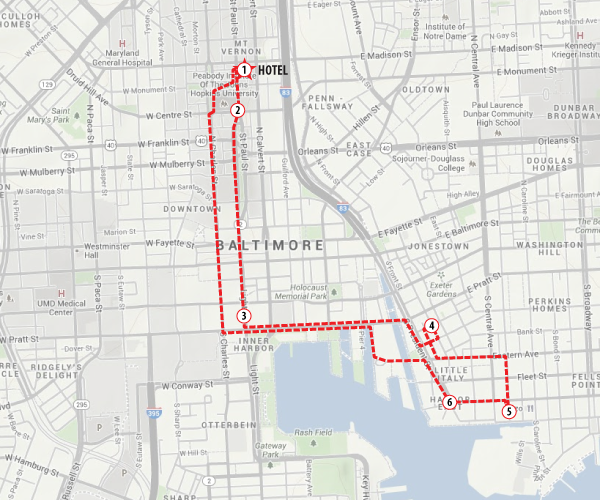Walking Distance, Part 1
Today I'm starting a two-part blog post on walking in cities. In the first part of this post, we'll look at the question of how far people are willing to walk in real-world circumstances. In the second part, we'll take a closer look at what affects walking distances.
Let's start with the basics. The most commonly accepted "pedestrian shed", or distance that people are willing to walk is 1/4 mi, or 400m. This distance comes from academic work studying the distance people are willing to walk to transit stops, which is actually a very different question. Transit expert Jarrett Walker does a great job explaining where this metric comes from, and how useful it is in the real world on his blog [1].
That said, this first blog post is primarily not about transit, but walking in general. I want to look at the idea of walking by itself, and question whether or not 1/4 mi. makes very much sense.
The inspiration for this post started with a recent trip my wife and I made to Baltimore, MD [2]. We stayed in a hotel in Mount Vernon, and one evening we decided we wanted to do dinner and a movie.
Here's a map of our route:

- We left our hotel heading south towards the waterfront.
- There was a convenient circulator bus running the same route we were walking, so we hopped on when one passed and used that to shorten one leg of our trip.
- From there we walked across the waterfront and into Little Italy (4), where we had dinner.
- From Little Italy we walked to a Wells-Fargo branch to visit the ATM (5).
- From the ATM we walked to the movie theater (6).
- After the movie we walked the whole way home, taking Charles St. most of the way.
Our travel distance? 2.27mi to the movie theater (0.68 mi on bus), 1.76 mi on the way home. 3.35mi total. That sounds like a lot, but at the time we didn't even notice.
Worth noting, the most direct route home would have been 1.4 mi, but that was using some oversized stroads. So, we added .36 mi to our route to walk on streets that felt safer.
The reason this inspired the blog post, is when we got home I realized we had probably walked more than a mile from the theater, and I was curious how far we had actually walked on our route. When I realized the round trip was more than 3 miles, I was surprised. It didn't feel like we went all that far. But, Baltimore is interesting, mostly pedestrian friendly, and we didn't have a car with us on this visit, so it was just the natural thing to do.
After sketching out some notes for this blog post I went to CNU 21 in Salt Lake City. As part of my interest in how far people really walk, I recently got a pedometer, and I brought this with me. The giant block pattern in Salt Lake City causes trips to be a little longer than you would expect in an urbanized area, but I was surprised to see my totals.

On Saturday of the CNU trip I walked 8.2 mi all together (18,127 steps). The above map includes a rough depiction of where I walked that day.
Now, I knew I had walked a lot that day, but it was spread throughout the whole day so I wasn't especially tired or sore at the day's end. I've been on trips (to Europe, Asia, and places like Disney World) where I'm sure I walked more than this in a day and was very tired at day's end.
These trips are good little snapshots of ordinary experiences for me, and the sum of these experiences has led me to conclude the following:
The 1/4mi walking distance may be relevant to how far people routinely travel to get to transit stops, but it has no relevance to how far people will walk when taking trips entirely on foot.
In my own life, and in comparing stories with many others, I find 1-2 mi. is much closer to the range that people will go on-foot without worrying about it, under the right circumstances.
People choose to walk or not to walk based on many factors. Among these factors, I believe distance much less important than people usually think.
How could distance not be so important, and what are the right circumstances for walking?
I'll come back with thoughts on that question in Part 2, Thursday, and Nate Hood will have a new blog post for us tomorrow.
Footnotes:
[1]: Jarrett Walker's website, Human Transit, is really a fantastic resource. Bookmark now, read regularly.
[2]: If you haven't been, Baltimore is worth a visit. It's a really wonderful city.
